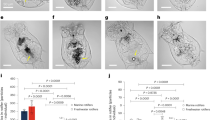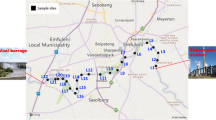Abstract
Plastic pollution in water ecosystems is threatening the survival of wildlife. In particular, microplastics may be encapsulated into calcium carbonate, a crucial building block of hard tissue in many species such as molluscs, corals, phytoplankton, sponges, echinoderms, and crustaceans. Actually little is known on the effect of humic acids, a common component of dissolved organic matter, on the encapsulation of microplastic into calcium carbonate. Here, we precipitated calcium carbonate with humic acids and polystyrene microspheres. The precipitation process was followed by measuring pH during the reaction. Composition, structure, morphology, surface properties and microspheres encapsulation extent were analysed by infrared spectroscopy, X-ray powder diffraction, atomic force microscopy, scanning electron microscopy, total organic carbon analysis, thermogravimetric analysis, nuclear magnetic resonance spectroscopy, electrophoretic and dynamic light scattering. Results show, for the first time, that encapsulation of polystyrene microspheres into calcite crystals occurs only after the treatment of the microspheres with humic acids, leading to encapsulation of about 5% of the initial microspheres mass. On the contrary, untreated microspheres did not encapsulate in calcium carbonate. Our findings imply that exposure of microplastics to dissolved organic matter in water ecosystems could result in enhanced encapsulation into the exoskeleton and endoskeleton of aquatic organisms.




Similar content being viewed by others
References
Abdurahman A, Cui K, Wu J et al (2020) Adsorption of dissolved organic matter (DOM) on polystyrene microplastics in aquatic environments: kinetic, isotherm and site energy distribution analysis. Ecotoxicol Environ Saf 198:110658–110664. https://doi.org/10.1016/j.ecoenv.2020.110658
Andersen FA, Brečević L (1991) Infrared spectra of amorphous and crystalline calcium carbonate. Acta Chem Scand 45:1018–1024. https://doi.org/10.3891/acta.chem.scand.45-1018
Białowąs M, Jonko-Sobuś K, Pawlak J, et al (2022) Plastic in digestive tract and gills of cod and herring from the Baltic Sea. Sci Total Environ 822:153333. https://doi.org/10.1016/j.scitotenv.2022.153333
Birarda G, Buosi C, Caridi F et al (2021) Plastics, (bio)polymers and their apparent biogeochemical cycle: an infrared spectroscopy study on foraminifera. Environ Pollut 279:116912–116924. https://doi.org/10.1016/j.envpol.2021.116912
Brewer A, Dror I, Berkowitz B (2021) The mobility of plastic nanoparticles in aqueous and soil environments: a critical review. ACS ES&T Water 1:48–57. https://doi.org/10.1021/acsestwater.0c00130
Cai L, Hu L, Shi H, et al (2018) Effects of inorganic ions and natural organic matter on the aggregation of nanoplastics. Chemosphere 197:142–151. https://doi.org/10.1016/j.chemosphere.2018.01.052
Chapron L, Peru E, Engler A et al (2018) Macro- and microplastics affect cold-water corals growth, feeding and behaviour. Sci Rep 8:15299–15307. https://doi.org/10.1038/s41598-018-33683-6
Chen C-S, Le C, Chiu M-H, Chin W-C (2018a) The impact of nanoplastics on marine dissolved organic matter assembly. Sci Total Environ 634:316–320. https://doi.org/10.1016/j.scitotenv.2018.03.269
Chen W, Ouyang ZY, Qian C, Yu HQ (2018b) Induced structural changes of humic acid by exposure of polystyrene microplastics: a spectroscopic insight. Environ Pollut 233:1–7. https://doi.org/10.1016/j.envpol.2017.10.027
Chin YP, Alken G, O’Loughlin E (1994) Molecular weight, polydispersity, and spectroscopic properties of aquatic humic substances. Environ Sci Technol 28:1853–1858. https://doi.org/10.1021/es00060a015
Ersts PJ (2016) [Internet] DotDotGoose (version 1.5.3). American Museum of Natural History, Center for Biodiversity and Conservation. Available from http://biodiversityinformatics.amnh.org/open_source/dotdotgoose. Accessed on [01.02.2022]
Fang J, Xuan Y, Li Q (2010) Preparation of polystyrene spheres in different particle sizes and assembly of the PS colloidal crystals. Sci China Technol Sci 53:3088–3093. https://doi.org/10.1007/s11431-010-4110-5
Feng S, Zeng Y, Cai Z et al (2021) Polystyrene microplastics alter the intestinal microbiota function and the hepatic metabolism status in marine medaka (Oryzias melastigma). Sci Total Environ 759:143558. https://doi.org/10.1016/j.scitotenv.2020.143558
Gorrasi G, Sorrentino A, Lichtfouse E (2021) Back to plastic pollution in COVID times. Environ Chem Lett 19:1–4. https://doi.org/10.1007/s10311-020-01129-z
Guzzetti E, Sureda A, Tejada S, Faggio C (2018) Microplastic in marine organism: environmental and toxicological effects. Environ Toxicol Pharmacol 64:164–171. https://doi.org/10.1016/j.etap.2018.10.009
Häder DP, Banaszak AT, Villafañe VE et al (2020) Anthropogenic pollution of aquatic ecosystems: emerging problems with global implications. Sci Total Environ 713:136586–136596. https://doi.org/10.1016/j.scitotenv.2020.136586
Hankins C, Duffy A, Drisco K (2018) Scleractinian coral microplastic ingestion: potential calcification effects, size limits and retention. Mar Pollut Bull 135:587–593. https://doi.org/10.1016/j.marpolbul.2018.07.067
Hierl F, Wu HC, Westphal H (2021) Scleractinian corals incorporate microplastic particles: identification from a laboratory study. Environ Sci Pollut Res 28:37882–37893. https://doi.org/10.1007/s11356-021-13240-x
Hoch AR, Reddy MM, Aiken GR (2000) Calcite crystal growth inhibition by humic substances with emphasis on hydrophobic acids from the Florida Everglades. Geochim Cosmochim Acta 64:61–72. https://doi.org/10.1016/S0016-7037(99)00179-9
John J, Nandhini AR, Velayudhaperumal Chellam P, Sillanpää M (2021) Microplastics in mangroves and coral reef ecosystems: a review. Environ Chem Lett. https://doi.org/10.1007/s10311-021-01326-4
Kim YY, Ribeiro L, Maillot F et al (2010) Bio-inspired synthesis and mechanical properties of calcite–polymer particle composites. Adv Mater 22:2082–2086. https://doi.org/10.1002/adma.200903743
Kim YY, Darkins R, Broad A et al (2019) Hydroxyl-rich macromolecules enable the bio-inspired synthesis of single crystal nanocomposites. Nat Commun 10:5682–5697. https://doi.org/10.1038/s41467-019-13422-9
Kniggendorf AK, Nogueira R, Lorey C, Roth B (2021) Calcium carbonate deposits and microbial assemblages on microplastics in oligotrophic freshwaters. Chemosphere 266:128942–128952. https://doi.org/10.1016/j.chemosphere.2020.128942
Kulak AN, Semsarilar M, Kim YY et al (2014) One-pot synthesis of an inorganic heterostructure: uniform occlusion of magnetite nanoparticles within calcite single crystals. Chem Sci 5:738–743. https://doi.org/10.1039/c3sc52615a
Lu S, Zhu K, Song W et al (2018) Impact of water chemistry on surface charge and aggregation of polystyrene microspheres suspensions. Sci Total Environ 630:951–959. https://doi.org/10.1016/j.scitotenv.2018.02.296
Mahadevan G, Ruifan Q, Hian Jane YH, Valiyaveettil S (2021) Effect of polymer nano- and microparticles on calcium carbonate crystallization. ACS Omega 6:20522–20529. https://doi.org/10.1021/acsomega.1c02564
Mann S (2001) Biomineralization: principles and concepts in bioinorganic materials chemistry. Oxford University Press on Demand, New York
Moulin P, Roques H (2003) Zeta potential measurement of calcium carbonate. J Colloid Interface Sci 261:115–126. https://doi.org/10.1016/S0021-9797(03)00057-2
Othman AR, Hasan HA, Muhamad MH et al (2021) Microbial degradation of microplastics by enzymatic processes: a review. Environ Chem Lett 19:3057–3073. https://doi.org/10.1007/s10311-021-01197-9
Perminova IV, Frimmel FH, Kudryavtsev AV et al (2003) Molecular weight characteristics of humic substances from different environments as determined by size exclusion chromatography and their statistical evaluation. Environ Sci Technol 37:2477–2485. https://doi.org/10.1021/es0258069
Pirsaheb M, Hossini H, Makhdoumi P (2020) Review of microplastic occurrence and toxicological effects in marine environment: experimental evidence of inflammation. Process Saf Environ Prot 142:1–14. https://doi.org/10.1016/j.psep.2020.05.050
Pokroy B, Fitch AN, Marin F et al (2006) Anisotropic lattice distortions in biogenic calcite induced by intra-crystalline organic molecules. J Struct Biol 155:96–103. https://doi.org/10.1016/j.jsb.2006.03.008
Prata JC, Venâncio C, Girão AV et al (2021) Effects of virgin and weathered polystyrene and polypropylene microplastics on Raphidocelis subcapitata and embryos of Danio rerio under environmental concentrations. Sci Total Environ 816:151642. https://doi.org/10.1016/j.scitotenv.2021.151642
Raghu AV, Jeong HM (2008) Synthesis, characterization of novel dihydrazide containing polyurethanes Based on N1, N2-Bis[(4-hydroxyphenyl)methylene]ethanedihydrazide and various diisocyanates. J Appl Polym Sci 107:3401–3407. https://doi.org/10.1002/app
Reichert J, Arnold AL, Hammer N et al (2022) Reef-building corals act as long-term sink for microplastic. Glob Chang Biol 28:33–45. https://doi.org/10.1111/gcb.15920
Sharma VK, Ma X, Guo B, Zhang K (2021) Environmental factors-mediated behavior of microplastics and nanoplastics in water: a review. Chemosphere 271:129597–129605. https://doi.org/10.1016/j.chemosphere.2021.129597
Singh N, Tiwari E, Khandelwal N, Darbha GK (2019) Understanding the stability of nanoplastics in aqueous environments: effect of ionic strength, temperature, dissolved organic matter, clay, and heavy metals. Environ Sci Nano 6:2968–2976. https://doi.org/10.1039/C9EN00557A
Štajner L, Kontrec J, Njegić Džakula B et al (2018) The effect of different amino acids on spontaneous precipitation of calcium carbonate polymorphs. J Cryst Growth 486:71–81. https://doi.org/10.1016/j.jcrysgro.2018.01.023
Stevenson FJ (1982) Humus chemistry: genesis, composition, reactions. Wiley, New York
Acknowledgements
A.L.B. appreciates the help from Ida Delač Marion and acknowledges the financial support from the European Regional Development Fund for the “Center of Excellence for Advanced Materials and Sensing Devices” (No. KK.01.1.1.01.0001). A.S. would like to thank Anton Paar Croatia d.o.o. Zagreb, Croatia, for providing the instrument Litesizer 500 for use and analysis. We thank Katarina Kajan for BioRender.com use for graphical abstract preparation, Giuseppe Falini for XRD discussions and Ana Čikoš for NMR discussions.
Funding
This work has been supported (N.M.M.) by the European Institute of Innovation and Technology obtained through EIT Climate-KIC Alumni ‘Participatory Grant-making’ Programme and in part (N. M., J.K., B. Nj. Dž. and D. K.) by Croatian Science Foundation under the project (IP-2013-11-5055).
Author information
Authors and Affiliations
Contributions
All authors contributed to the study’s conception and design. Material preparation, data collection and analysis were performed by Nives Matijaković Mlinarić, Atiđa Selmani, Antun Lovro Brkić, Jasminka Kontrec and Branka Njegić Džakula. The funding was provided by Nives Matijaković Mlinarić and Damir Kralj. The first draft of the manuscript was written by Nives Matijaković Mlinarić, and all authors commented on previous versions of the manuscript.
Corresponding authors
Ethics declarations
Conflict of interest
All authors declare that they have no conflict of interest.
Consent for publication
All authors read and approved the final manuscript.
Additional information
Publisher's Note
Springer Nature remains neutral with regard to jurisdictional claims in published maps and institutional affiliations.
Supplementary Information
Below is the link to the electronic supplementary material.
Rights and permissions
About this article
Cite this article
Matijaković Mlinarić, N., Selmani, A., Brkić, A.L. et al. Exposure of microplastics to organic matter in waters enhances microplastic encapsulation into calcium carbonate. Environ Chem Lett 20, 2235–2242 (2022). https://doi.org/10.1007/s10311-022-01433-w
Received:
Accepted:
Published:
Issue Date:
DOI: https://doi.org/10.1007/s10311-022-01433-w




